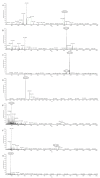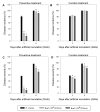Genomic Analysis and Secondary Metabolites Production of the Endophytic Bacillus velezensis Bvel1: A Biocontrol Agent against Botrytis cinerea Causing Bunch Rot in Post-Harvest Table Grapes
- PMID: 34451760
- PMCID: PMC8400388
- DOI: 10.3390/plants10081716
Genomic Analysis and Secondary Metabolites Production of the Endophytic Bacillus velezensis Bvel1: A Biocontrol Agent against Botrytis cinerea Causing Bunch Rot in Post-Harvest Table Grapes
Abstract
Botrytis bunch rot caused by Botrytis cinerea is one of the most economically significant post-harvest diseases of grapes. In the present study, we showed that the bacterial strain Bvel1 is phylogenetically affiliated to Bacillus velezensis species. The strain Bvel1 and its secreted metabolites exerted an antifungal activity, under in vitro conditions, against B. cinerea. UHPLC-HRMS chemical analysis revealed that iturin A2, surfactin-C13 and -C15, oxydifficidin, bacillibactin, L-dihydroanticapsin, and azelaic acid were among the metabolites secreted by Bvel1. Treatment of wounded grape berries with Bacillus sp. Bvel1 cell culture was effective for controlling grey mold ingress and expansion in vivo. The effectiveness of this biological control agent was a function of the cell culture concentration of the antagonist applied, while preventive treatment proved to be more effective compared to curative. The strain Bvel1 exhibited an adequate colonization efficiency in wounded grapes. The whole-genome phylogeny, combined with ANI and dDDH analyses, provided compelling evidence that the strain Bvel1 should be taxonomically classified as Bacillus velezensis. Genome mining approaches showed that the strain Bvel1 harbors 13 antimicrobial biosynthetic gene clusters, including iturin A, fengycin, surfactin, bacilysin, difficidin, bacillaene, and bacillibactin. The results provide new insights into the understanding of the endophytic Bacillus velezensis Bvel1 biocontrol mechanism against post-harvest fungal pathogens, including bunch rot disease in grape berries.
Keywords: biological control; colonization; endophytic bacteria; genome sequence; induced systemic resistance; iturin A; metabolites; surfactin.
Conflict of interest statement
The authors declare that they have no conflict of interest.
Figures






Similar articles
-
Whole Genome Sequencing of Bacillus velezensis AMR25, an Effective Antagonist Strain against Plant Pathogens.Microorganisms. 2024 Jul 26;12(8):1533. doi: 10.3390/microorganisms12081533. Microorganisms. 2024. PMID: 39203375 Free PMC article.
-
Integrated Genomic and Metabolomic Analysis Illuminates Key Secreted Metabolites Produced by the Novel Endophyte Bacillus halotolerans Cal.l.30 Involved in Diverse Biological Control Activities.Microorganisms. 2022 Feb 9;10(2):399. doi: 10.3390/microorganisms10020399. Microorganisms. 2022. PMID: 35208854 Free PMC article.
-
Genome mining and UHPLC-QTOF-MS/MS to identify the potential antimicrobial compounds and determine the specificity of biosynthetic gene clusters in Bacillus subtilis NCD-2.BMC Genomics. 2020 Nov 5;21(1):767. doi: 10.1186/s12864-020-07160-2. BMC Genomics. 2020. PMID: 33153447 Free PMC article.
-
Bacillus velezensis: A Valuable Member of Bioactive Molecules within Plant Microbiomes.Molecules. 2019 Mar 16;24(6):1046. doi: 10.3390/molecules24061046. Molecules. 2019. PMID: 30884857 Free PMC article. Review.
-
Botrytis cinerea and Table Grapes: A Review of the Main Physical, Chemical, and Bio-Based Control Treatments in Post-Harvest.Foods. 2020 Aug 19;9(9):1138. doi: 10.3390/foods9091138. Foods. 2020. PMID: 32824971 Free PMC article. Review.
Cited by
-
Calendula officinalis-A Great Source of Plant Growth Promoting Endophytic Bacteria (PGPEB) and Biological Control Agents (BCA).Microorganisms. 2023 Jan 13;11(1):206. doi: 10.3390/microorganisms11010206. Microorganisms. 2023. PMID: 36677498 Free PMC article.
-
Metabolic profiling and antibacterial activity of secondary metabolites extracted from the endophytic bacteria of Combretum erythrophyllum.Sci Rep. 2025 Apr 27;15(1):14739. doi: 10.1038/s41598-025-99709-y. Sci Rep. 2025. PMID: 40289198 Free PMC article.
-
Functional Endophytes Regulating Plant Secondary Metabolism: Current Status, Prospects and Applications.Int J Mol Sci. 2023 Jan 6;24(2):1153. doi: 10.3390/ijms24021153. Int J Mol Sci. 2023. PMID: 36674663 Free PMC article. Review.
-
Mechanisms of Action of Microbial Biocontrol Agents against Botrytis cinerea.J Fungi (Basel). 2021 Dec 6;7(12):1045. doi: 10.3390/jof7121045. J Fungi (Basel). 2021. PMID: 34947027 Free PMC article. Review.
-
Suppression of Grape White Rot Caused by Coniella vitis Using the Potential Biocontrol Agent Bacillus velezensis GSBZ09.Pathogens. 2022 Feb 14;11(2):248. doi: 10.3390/pathogens11020248. Pathogens. 2022. PMID: 35215191 Free PMC article.
References
-
- Poveda J., Barquero M., González-Andrés F. Insight into the microbiological control strategies against Botrytis cinerea using systemic plant resistance activation. Agronomy. 2020;10:1822. doi: 10.3390/agronomy10111822. - DOI
-
- Jiang C.M., Shi J.L., Liu Y.L., Zhu C.Y. Inhibition of Aspergillus carbonarius and fungal contamination in table grapes using Bacillus subtilis. Food Control. 2014;35:41–48. doi: 10.1016/j.foodcont.2013.06.054. - DOI
-
- Pertot I., Giovannini O., Benanchi M., Caffi T., Rossi V., Mugnai L. Combining biocontrol agents with different mechanisms of action in a strategy to control Botrytis cinerea on grapevine. Crop Prot. 2017;97:85–93. doi: 10.1016/j.cropro.2017.01.010. - DOI
LinkOut - more resources
Full Text Sources

